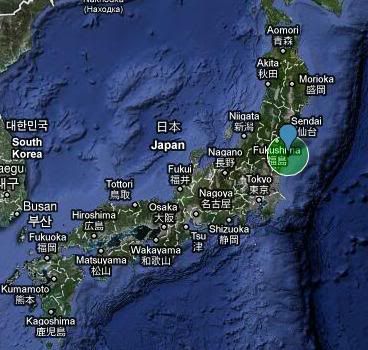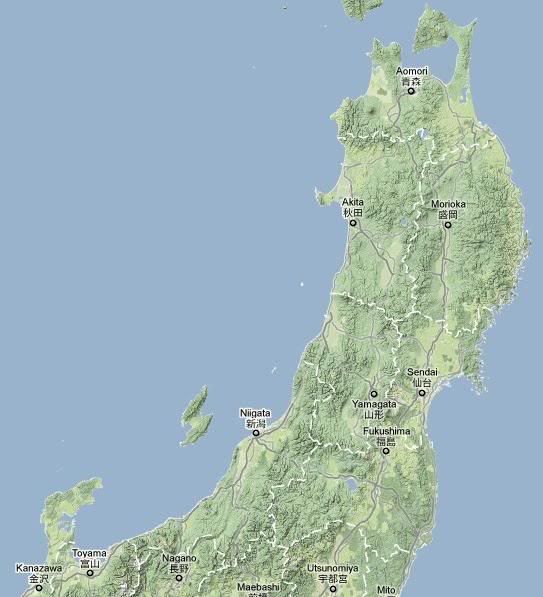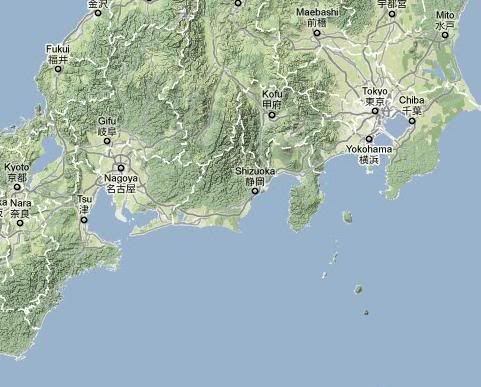First, is the NASA image of the tsunami infiltrating land on March 12th, 2011 following the 9.0 earthquake. For larger images click on the link. The red spot is the fire at the Chiba refinery. Note that the city of Sendai is marked on the image.
Flooding from Tsunami near Sendai, Japan NASA’s Terra satellite's first view of northeastern Japan in the wake of a devastating earthquake and tsunami reveal extensive flooding along the coast. The Moderate Resolution Imaging Spectroradiometer (MODIS) acquired the right image of the Sendai region on March 12, 2011, at 10:30 a.m. The left image, taken by Terra MODIS on February 26, 2011, is provided as a point of reference.
Water is black or dark blue in these images. It is difficult to see the coastline in the March 12 image, but a thin green line outlines the shore. This green line is higher-elevation land that is above water, presumably preventing the flood of water from returning to the sea. The flood indicator on the left image illustrates how far inland the flood extends.
______________________________
This map shows the location of the Fukushima reactor I. Note its proximity to Tokyo.

See: Fukushima I Nuclear Power Plant and Fukushima II Nuclear Power Plant
______________________________
This next map shows the location of other Japanese nuclear stations.

______________________________
In the following three topographical maps of Japan, the lighter green, nonmountainous areas roughly represent the agricultural growing regions. In Japan, only 12-13% of its land, or about 19,000 square miles are farmable due to its mountainous topography. The average farm size is less than five acres, and the average farmer is over 65 years of age. The nation imports 60% of its calories.
The first map is the northeastern region which was most affected by the earthquake. Sendai was near its epicenter. The second is the middle-section of Japan, and the third map is the southwestern region of Japan.



ALSO SEE PREVIOUS POST: What Effect will the recent Tsunami, Earthquake, and Nuclear Disaster have upon Japan's Agriculture?
Flooding from Tsunami near Sendai, Japan
Water is black or dark blue in these images. It is difficult to see the coastline in the March 12 image, but a thin green line outlines the shore. This green line is higher-elevation land that is above water, presumably preventing the flood of water from returning to the sea. The flood indicator on the left image illustrates how far inland the flood extends.
This map shows the location of the Fukushima reactor I. Note its proximity to Tokyo.

See: Fukushima I Nuclear Power Plant and Fukushima II Nuclear Power Plant
This next map shows the location of other Japanese nuclear stations.

In the following three topographical maps of Japan, the lighter green, nonmountainous areas roughly represent the agricultural growing regions. In Japan, only 12-13% of its land, or about 19,000 square miles are farmable due to its mountainous topography. The average farm size is less than five acres, and the average farmer is over 65 years of age. The nation imports 60% of its calories.
The first map is the northeastern region which was most affected by the earthquake. Sendai was near its epicenter. The second is the middle-section of Japan, and the third map is the southwestern region of Japan.



ALSO SEE PREVIOUS POST: What Effect will the recent Tsunami, Earthquake, and Nuclear Disaster have upon Japan's Agriculture?
